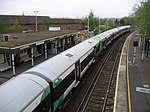Imberhorne Viaduct
Bluebell RailwayBridges completed in 1882East GrinsteadGrade II listed buildings in West SussexRailway viaducts in West Sussex ... and 1 more
Use British English from July 2015

Imberhorne Viaduct is a Grade II listed railway viaduct located in East Grinstead, West Sussex, South-East England. Closed in 1958, the structure was brought back into use as part of the preserved Bluebell Railway heritage line in 2013, allowing trains to continue to East Grinstead railway station.
Excerpt from the Wikipedia article Imberhorne Viaduct (License: CC BY-SA 3.0, Authors, Images).Imberhorne Viaduct
Garden Wood Road, Mid Sussex Sunnyside
Geographical coordinates (GPS) Address Nearby Places Show on map
Geographical coordinates (GPS)
| Latitude | Longitude |
|---|---|
| N 51.12309 ° | E -0.023446 ° |
Address
Garden Wood Road 151
RH19 1SH Mid Sussex, Sunnyside
England, United Kingdom
Open on Google Maps








